In this blog, we’ll highlight how you can expand the knowledge of Copilot for Microsoft 365 with Microsoft Graph connectors and build custom solutions for your business leveraging the data and services in Microsoft Graph APIs.
In the world of building generative AI solutions, you can use Microsoft Graph APIs to interact with your collaboration data and perform productivity tasks. We’re excited to share our latest updates and for you to try them out!
Copilot extensions and Copilot connectors
At Build, we introduced Copilot extensions to expand the actions that Microsoft Copilot can take on the user’s behalf, customize grounding knowledge with relevant business data, and enable hand-off to other copilots.
We also introduced Copilot connectors in Copilot Studio to simplify how developers connect their business and collaboration data to their copilots. Copilot connectors include Microsoft Power Platform connectors, Microsoft Graph connectors, and Power Query connectors—with Microsoft Fabric integrations coming soon. Read more about Copilot connectors and other Copilot Studio announcements here.
Microsoft Graph connectors in Microsoft Copilot Studio
Let’s take a deeper look at Copilot connectors in Microsoft Copilot Studio. Anyone with a valid Copilot license can create custom copilots, use Graph connectors as a source of knowledge, and publish them as copilots either within Microsoft Copilot or third-party applications. Microsoft Copilot Studio utilizes Graph connectors to enhance the capabilities of copilots by integrating knowledge from third-party systems like JIRA, Confluence, on-prem file share etc. This integration allows makers to add a variety of data sources within their enterprise to augment the generative AI capabilities of various copilots, to suit their specific needs and workflows. These capabilities can be further enhanced by utilizing additional Microsoft Copilot Studio features such as custom workflows, generative actions etc. This capability allows integration of Graph connectors as a knowledge source to Microsoft Copilot Studio.
Imagine you want to create a custom copilot as a student accommodation assistant on your website. Start by integrating it with your organization’s real-time data, enabling multi-turn chat on topics like product information. For critical functions like account management, design specific conversational flows using visual authoring or natural language before deploying generative AI.
Ground your copilot with 150+ available Graph connectors as knowledge, allowing the copilot to handle queries from multiple sources.
 Create Copilot extensions from Microsoft Copilot Studio
Create Copilot extensions from Microsoft Copilot Studio
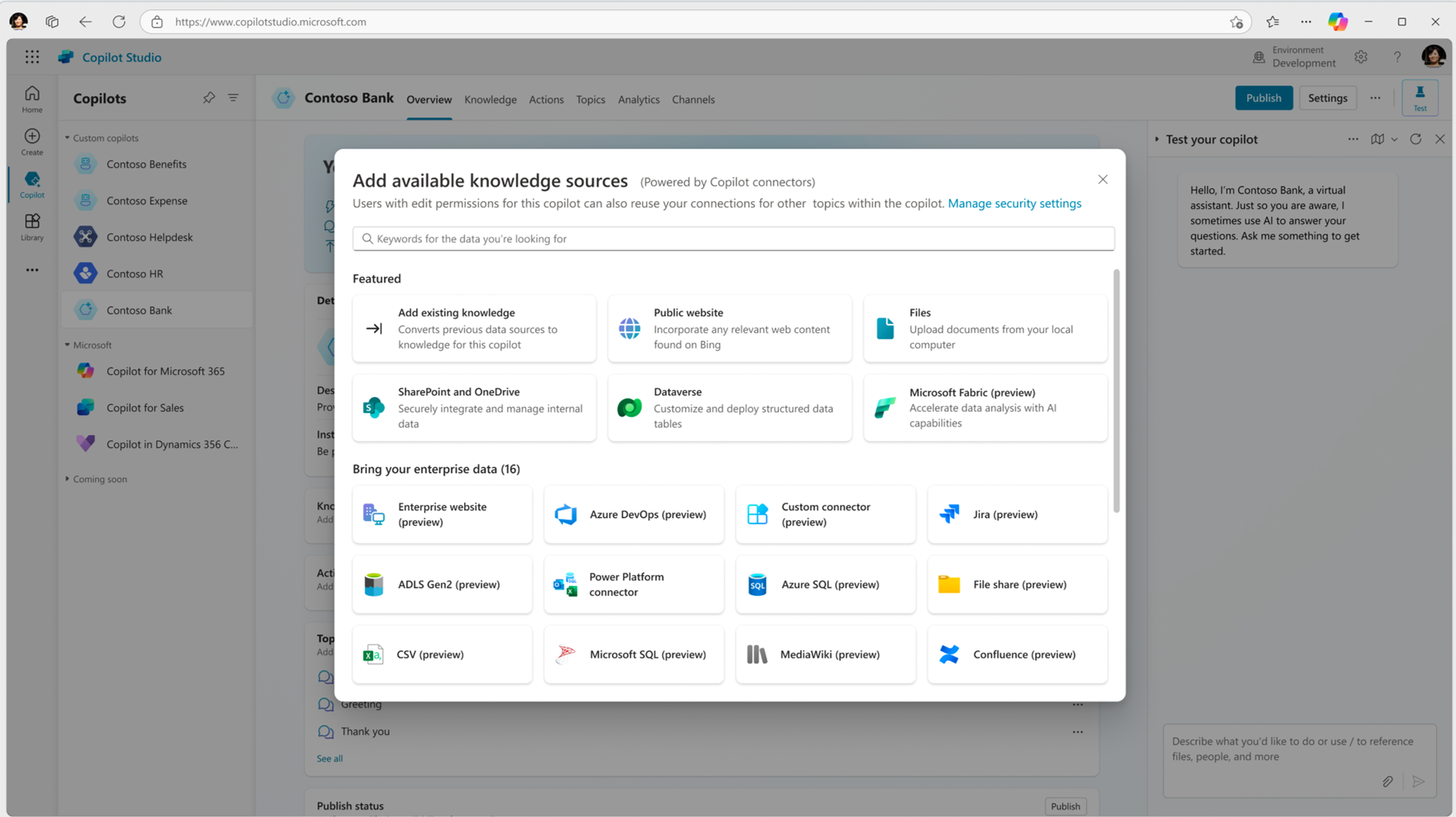 Different knowledge sources for creating Copilot extension using Microsoft Copilot Studio
Different knowledge sources for creating Copilot extension using Microsoft Copilot Studio
Publish your copilot across multiple platforms, such as websites, Microsoft Teams, and social apps, with escalation options to tools like Dynamics 365 for human assistance. Monitor performance via a built-in analytics dashboard and ensure data protection with governance features in the central admin center. Apart from these foundational steps, makers can utilize many other features in your custom copilot.
Building Copilot extensions using Microsoft Graph connectors
With our new capability, admins can now create Copilot extensions using one or more Graph connectors, directly from the Microsoft 365 Admin Center. This capability, currently in private preview, leverages the power of Microsoft Graph connectors to enrich Copilot’s organizational knowledge, enabling it to process and communicate in natural language more effectively.
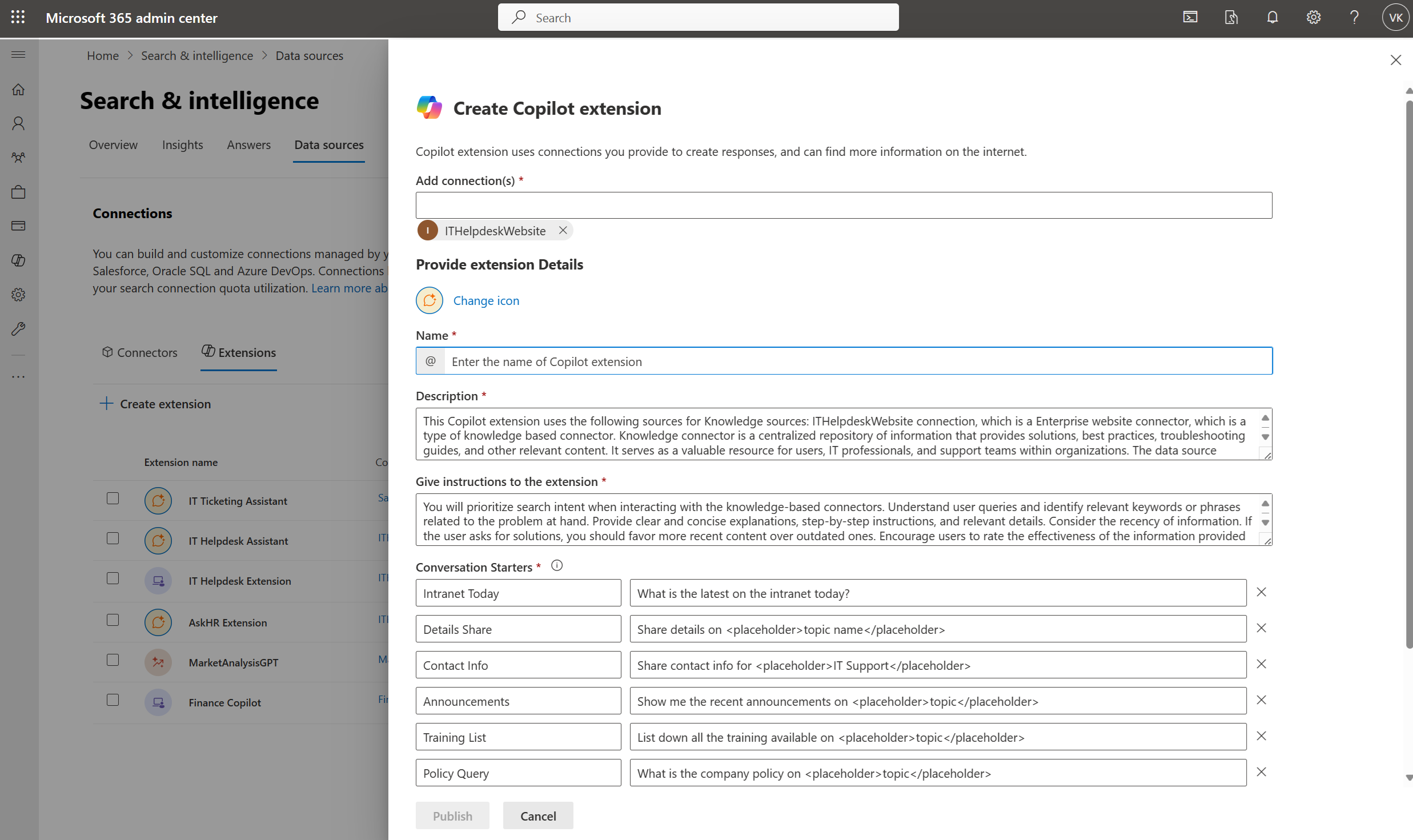 Create Copilot extension panel in Search & Intelligence portal
Create Copilot extension panel in Search & Intelligence portal
The new feature allows for targeted searches, natural language queries, and custom communications in the form of predefined prompts, all within the familiar Copilot for Microsoft 365 interface on semantically indexed third party data in Microsoft Graph. With the ability to control deployment to specific users or groups, admins can ensure a personalized and secure experience. Stay tuned for the public release in July and reach out if you are interested in early access to this innovative way of enhancing Copilot functionality.
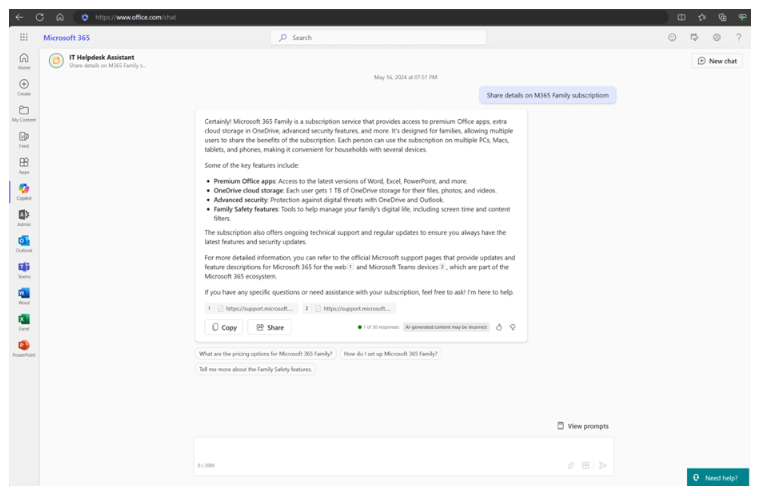 Access the created extension from Copilot for Microsoft 365
Access the created extension from Copilot for Microsoft 365
Simplified setup for Microsoft Graph connectors
We’re happy to share that we have made it easier than ever for admins to set up Graph connectors! The new simplified flow reduces the number of mandatory steps required to configure and publish a connection. We’ve also implemented intelligent defaults based on what works best for each Graph connector. Admins can easily review and adjust these defaults as needed. This simplified setup is now available for all Microsoft-built Graph connectors.
 Simplified flow to create Graph connectors from Search & Intelligence portal
Simplified flow to create Graph connectors from Search & Intelligence portal
Enhanced connection statistics for Microsoft Graph connector admins
Connection statistics is an essential tool for admins to gain precise insights into crawled and indexed items. This enhancement will help admins in comprehending the total number of items discovered, successfully indexed, or failed across all crawls. It will provide a cumulative perspective on the sync between the data source and Microsoft Graph connector index. With this enhancement, admins can swiftly identify discrepancies and ensure that their connection is up to date. Connection statistics is coming soon to general availability.
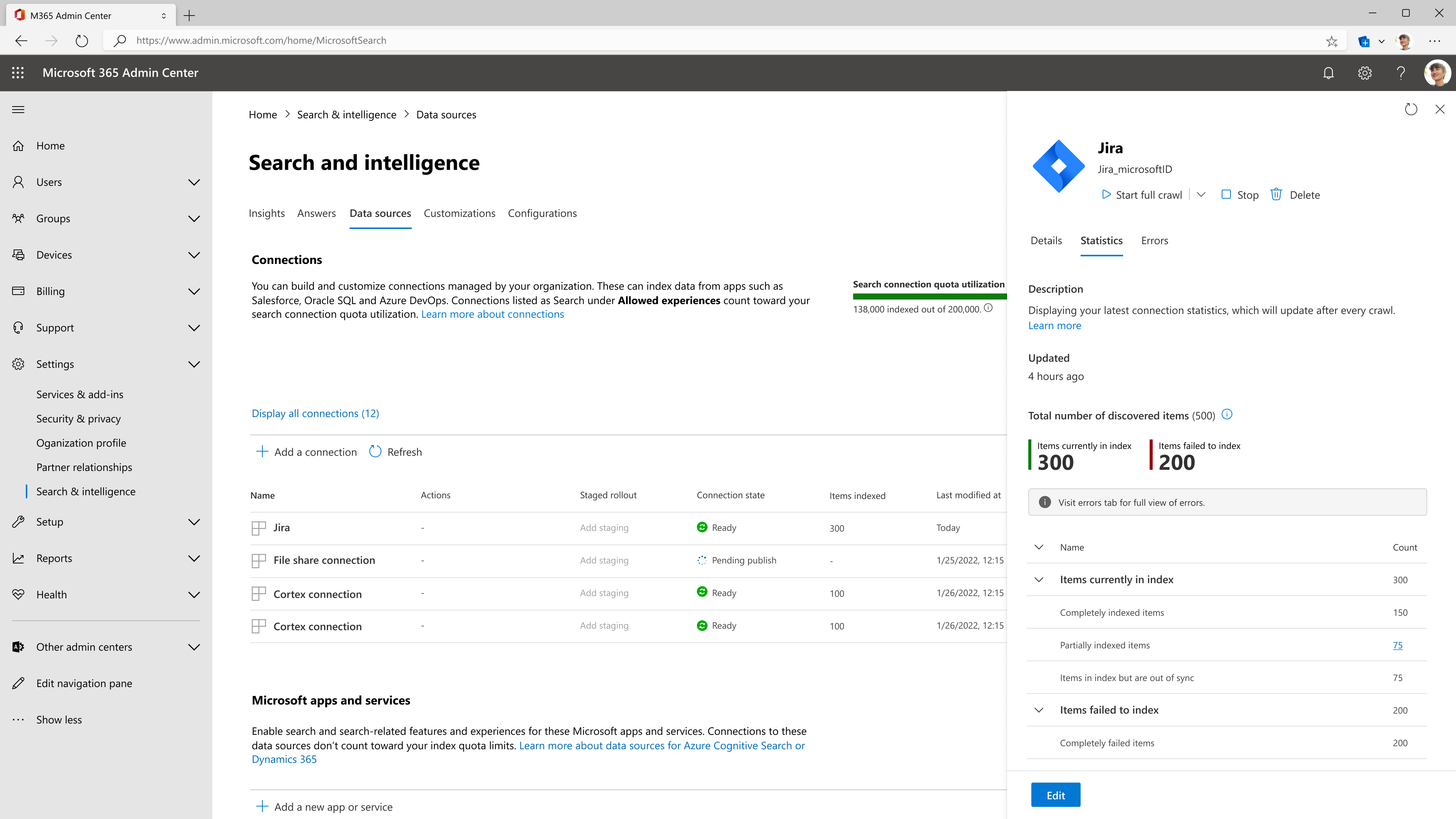 Connector statistics in Search & Intelligence portal
Connector statistics in Search & Intelligence portal
Microsoft Teams API updates
Developers leverage Microsoft Teams to build solutions for cross-industry, business-to-consumer (B2C) online meeting workflows in use cases such as clinician-led consultations (healthcare), banking and lending (financial services), and apparel purchases (retail). The new Microsoft Graph SMS Notification and Reminder APIs, now generally available, reduce no shows and facilitate a seamless customer experience that allow external attendees to receive SMS text notifications and reminders with an embedded join link.
External attendees receive confirmation and reminder SMS notifications
Microsoft Teams app developers can send Microsoft Teams activity notifications to users without making manifest changes to their app. This is possible via the now generally available systemDefault property of Microsoft Teams sendActivityNotification API.
Available in public preview, users are able to subscribe to changes in any chat at user-level. This lets users receive Microsoft Graph API change notifications for all changes across all chats that a specific user is a part of.
A new query parameter “notifyOnUserSpecificProperties” lets users get properties for a chat, like “viewpoint”, which shows when the user read the last message and whether the chat is hidden. This is useful for developers who use Microsoft Graph Toolkit to make chat clients, for example. This query parameter is available in public preview, and users will be able to get these properties if they have a subscription to a specific chat or a subscription to all chats that a specific user is part of.
In addition, developers can now see how custom emojis appear in the Microsoft Teams message body and how custom emoji reactions are part of Microsoft Teams message reactions. This feature is available in a public preview release of Chat and Channel Get Message APIs.
Approvals in Microsoft Teams APIs are coming soon in public preview. These APIs will enable developers to programmatically create, manage, and delete approvals, making it easier to hook line of business apps into the Microsoft Approvals Hub.
SharePoint API updates
SharePoint Pages API, now generally available, enables developers to manage SharePoint Pages programmatically, opening doors to incredible customization and automation opportunities. For example, developers can fetch page content programmatically for a third-party process flow or power a bot-like experience to help end users get answers from content in a page. Developers could also create pages and news posts programmatically on a schedule and at scale.
SharePoint Premium document processing APIs, coming soon in public preview, will enable developers to programmatically access Syntex document processing models. For example, developers can use the APIs to apply a Syntex document processing model to document libraries and get a Syntex document processing model by name or id. Developers can also run document processing jobs to process files in these document libraries. Developers can also run document processing jobs to process files in these document libraries.
Other API updates
Custom Claims API, coming soon in public preview, addresses the disparity between our type 2 (claims issuance) and type 14 (claims mapping) policies for claims management in Microsoft Entra ID. It allows admins to use Microsoft Entra Portal and Microsoft Graph API interchangeably to configure and manage optional claims for their enterprise applications, enabling them to no longer be mutually exclusive. Additionally, any updates made to the optional claims through Custom Claims API are logged in audit log for review and audit requirements.
Additionally, we’ve launched the Custom Claims Providers capability, which enables developers to augment tokens with custom claims from external data sources. For example, developers could bring data from legacy on-prem data stores via an API into the authentication process and have Microsoft Entra issue tokens with the data as custom claims, thus providing this data to applications without the need to update application logic. This feature and the supporting Graph APIs to enable these custom authentication extensions are now generally available!
ExportJobs API, now generally available, can be used for reporting and data export scenarios. We continue to update available reports, and through exportJobs, you can improve throughput and minimize Microsoft Graph API calls to get Intune data for common scenarios.
For more Microsoft Graph API updates, see What’s new in Microsoft Graph.
Microsoft Graph tooling updates
Microsoft Graph Toolkit v4.0, now generally available, is packed with new capabilities, improvements to the developer experience, and bug fixes that will be appreciated by end-users. Users can now edit To Do items directly using the Microsoft Graph Toolkit components and see colleagues’ presence and cards when selecting them via our people picker. We also promoted our search components to their general availability, and they are now fully supported.
Microsoft Graph Java client library v6, now generally available, is generated using Kiota, our code generator that produces more efficient and easier to use libraries. Kiota enables us to provide a consistent and fluent API across different platforms and new features to enhance your development experience. On top of that, this library also makes available new pagination support (PageIterator implementation), ODataCast support, and a backing store.
Microsoft Graph service capabilities updates
Bicep templates for Microsoft Graph resources allow you to define the tenant infrastructure you want to deploy, such as groups or applications, in a file, then use the file throughout the development lifecycle to repeatedly deploy your infrastructure. The file uses the Bicep language, a domain-specific language (DSL) that uses declarative syntax to deploy resources, typically for your infrastructure-as-code solutions. This capability is now available in public preview.
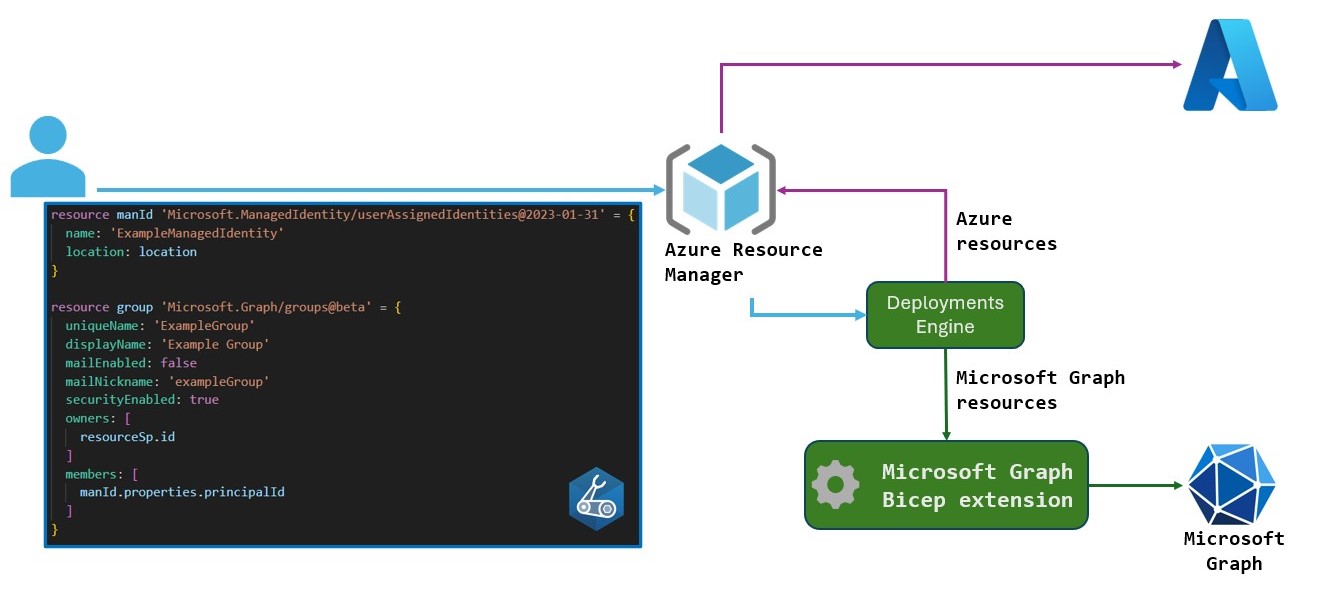 Deploying a Bicep file containing Microsoft Graph resources
Deploying a Bicep file containing Microsoft Graph resources
Microsoft Graph activity logs, now generally available, give you visibility into HTTP requests made to the Microsoft Graph service in your tenant. With rapidly growing security threats and an increasing number of attacks, this log data source allows you to perform security analysis, threat hunting, and monitor application activity in your tenant. You can store and query the logs in an Azure Log Analytics Workspace and use the full set of Azure Monitor Logs features, such as a portal query experience, alerting, saved queries, and workbooks. You can also archive the logs in Azure Storage accounts or export to other security information and event management (SIEM) tools through Azure Event Hubs.
EventHub has always been an easy and powerful tool for receiving Microsoft Graph Notifications without having to set up your own web server endpoint. Now it’s even more secure as you can use role-based access controls to set up your EventHub to receive notifications from Microsoft Graph without having to share access to your KeyVault.
Closing thoughts
Thank you for taking the time to read through our announcements. We look forward to seeing what you build leveraging the data and services of Microsoft Graph. There are more possibilities than ever to create custom workflows, provide custom experiences, automate business processes, and build generative AI solutions on top of Microsoft Graph. Happy building!
Follow us on X (Twitter) / @Microsoft365Dev, LinkedIn, and subscribe to our YouTube channel to stay up to date on the latest developer news and announcements.



Amazing work Jason, thanks a lot from France !